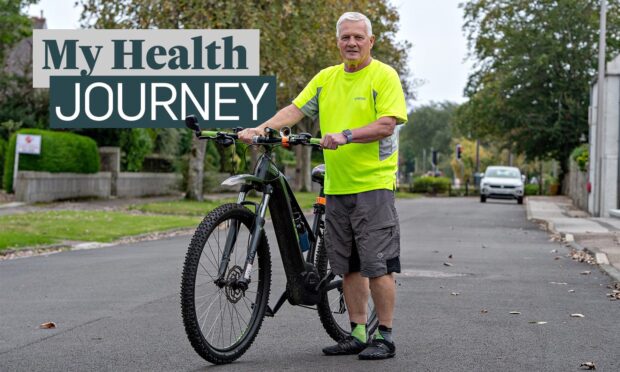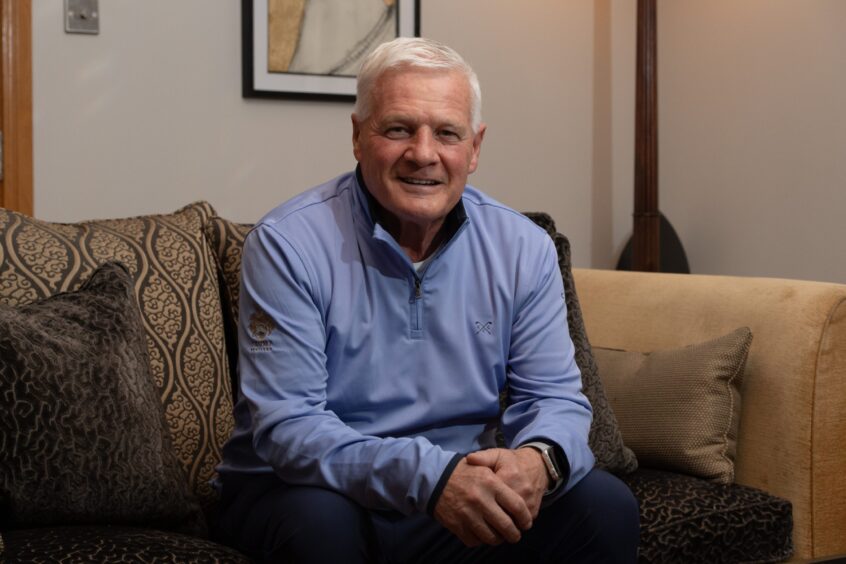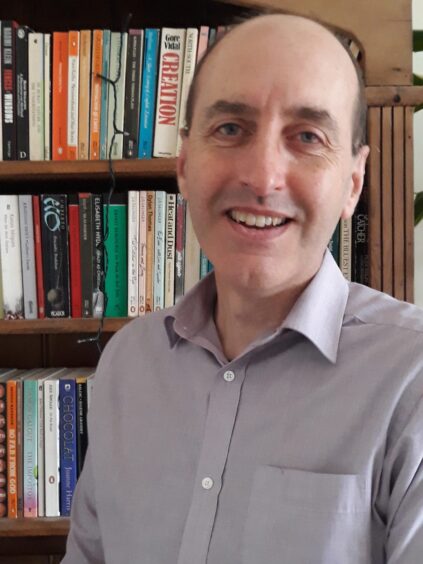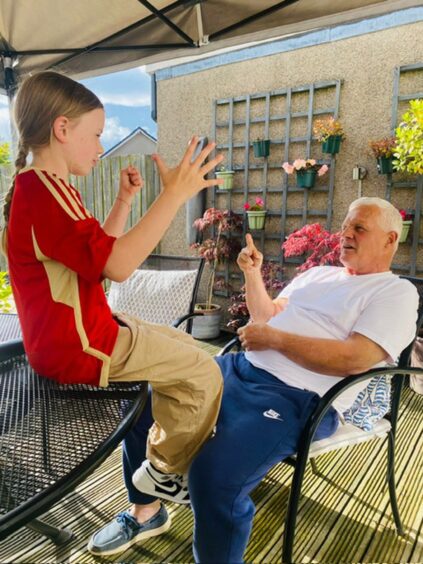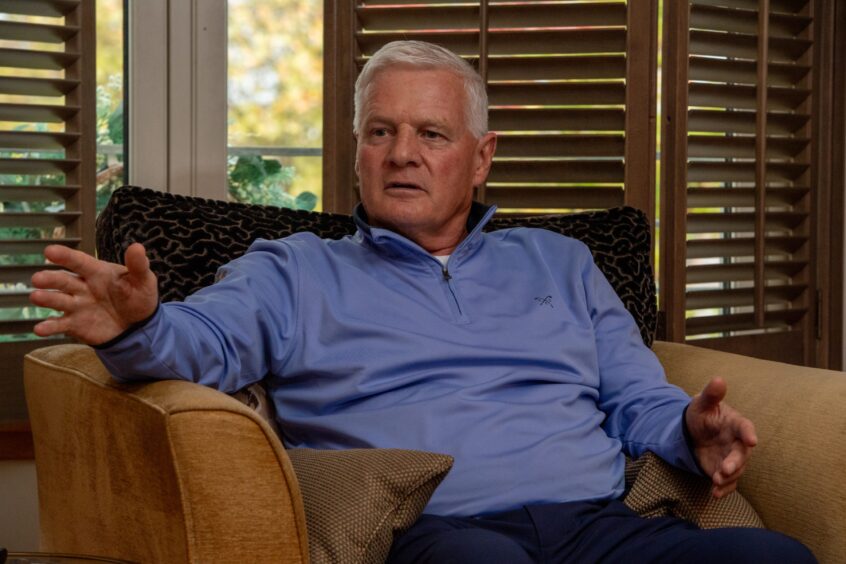Shortly after Ian Aitchison’s stroke, hospital staff looking after him were faced with an unusual problem.
Ian kept getting out of bed to go to the toilet.
“They said to me, ‘What are you trying to do?’,” he recalls, still exasperated at the memory. “They said ‘You don’t do that here. We do everything for you’.”
“Eventually they got fed up with me. That’s when they told me there is no toilet.”
In a stroke ward, the toilet is a bed pan, handled by a care worker because the patient can’t do it themselves.
But Ian is different. After suffering a stroke at home in Rubislaw on August 8, the 71-year-old Aberdonian was rushed to Dundee’s Ninewells Hospital for a — currently — rare procedure called a mechanical thrombectomy.
Hailed by charity group The Stroke Association as one of the “most effective medical interventions ever developed”, a thrombectomy is a highly specialised procedure that removes the blood clot in the brain that has caused the stroke.
The non-invasive surgery cannot be carried out on all patients, but in the right circumstances it significantly reduces the likelihood of stroke side-effects such as paralysis, blindness or difficulties speaking.
For Ian, the treatment has been life-changing.
Just eight weeks on from his stroke, the avid golfer is back playing his favourite north-east courses twice a week. He’s also back on his e-bike making frequent trips into town.
It’s a near-miracle recovery compared to stroke patients treated with other procedures.
“I would say that I’m 90% recovered,” Ian says. “People can’t believe that I had a stroke.”
Just one in ten stroke patients eligible for thrombectomy
Ian is one of the lucky ones. In Scotland last year, only 112 stroke patients out of a reported 11,257 cases had a thrombectomy, according to the national stroke audit.
Much of that is because only an estimated 10% of stroke patients are eligible. However, health bodies know more can be done.
The Scottish Government, through Public Health Scotland, has committed itself to increasing access to thrombectomies.
As part of a plan launched in 2020, three hospitals across the country – in Glasgow, Edinburgh and Dundee – can now perform the specialist procedure.
However, because a thrombectomy has to be done within a six-hour window, patients in the north and north-east of Scotland can be left stranded.
As one recent study put it, thrombectomy access in the UK is a “considerable postcode lottery”.
It is also a matter of timing. As the specialist centres currently only operate from 9am to 5pm, if you have a stroke out of office hours there’s little chance you can get a thrombectomy, no matter your eligibility.
It’s a far cry from England’s 24 thrombectomy centres, where access is 24/7 in some NHS regions.
Last year, 2,648 mechanical thrombectomies were carried in out England, thanks to the increased access.
The Stroke Association is calling for better service for Scotland.
Just how good is this fancy thrombectomy treatment?
“Thrombectomy is not just one of the best stroke treatments, it is one of the most effective treatments available across the NHS,” says John Watson, associate director Scotland at the Stroke Association.
“Yet the great majority of people who need the procedure don’t get it. This costs lives and leaves too many people living with ongoing disability.”
Ian describes the time around his stroke as the “worst week of my life”. But in terms of being able to get a thrombectomy, it may also have been his luckiest.
Firstly, he had his stroke just as he was getting out of bed.
It was Tuesday morning on August 8, a few days after Ian had been at the autumn international rugby at Murrayfield, where Scotland edged France in a pulsating game.
Ian had enjoyed the celebrations. But he couldn’t understand why when he tried to stand on his left leg it collapsed underneath him and sent him sprawling.
That’s when his second piece of luck – his wife Mandy – found him on the floor. Mandy is an HR director who knows her way around a first-aid course. She immediately knew Ian was having a stroke.
She called 999 and was able to accurately describe his condition to call handlers and paramedics.
He was admitted to Aberdeen Royal Infirmary at around 9am, where he had two scans to identify the clot on his brain.
The decision was quickly made to send him down to Dundee for the thrombectomy and Ian was shoveled into an ambulance and blue-lighted down the A92.
Trip to Dundee has Ian ‘shaking around in a box’
There was one more hitch that could have sunk the whole procedure.
Just outside Aberdeen Ian felt the throb of a headache in his left temple.
Fearing his blood clot was moving, paramedics returned him to ARI for a third scan.
But his luck stood firm. Ian was given the all clear and loaded back into the ambulance for the one-and-a-half hour ride to Dundee.
It’s not a trip Ian remembers fondly.
“I was lying flat, strapped in shaking around in a box with the sirens and lights going,” he says. “It was extra stress that I didn’t need.”
The start of Ian’s recovery
Surgeons were waiting for Ian when he finally made it to Dundee and he was whisked straight into the operating theatre.
Under sedation, a wire was inserted into his groin and maneuvered up to his brain to remove the clot. The operation was a success.
He says his memories of Ninewells are “a bit sketchy”, as are the first few days of his recovery.
When Mandy visited him in hospital, he was surprised when she told him he was in ARI. He couldn’t remember the return trip from Dundee.
But he quickly got back on track.
In his week-three assessment, when asked who the prime minister is, he could only recall Rishi Sunak’s first name.
But he passed other tests with flying colours, including ones posed to him by granddaughter Maddison in his back garden the day after he was discharged from ARI.
“I’m not a doctor, but in my own head, I feel that I’ve got stronger and stronger as the weeks have gone past,” he says. “Maybe even daily.”
One thing he clearly remembers, is that when he was first admitted to hospital medical staff were fixated on when exactly he’d had his stroke.
“They kept asking me, what time did this happen?” Ian recalls. “And they were saying, ok, we’ve got till lunchtime.”
The clock was ticking. Every second counted. It was Ian’s good fortune that he had time to reach Dundee.
Indeed, his only piece of bad luck was living in Aberdeen.
The plan to give everyone access to thrombectomies
Last year, the Scottish Government published a document that outlined a path to 24/7 access to mechanical thrombectomies no matter where the person has a stroke in Scotland.
Once implemented, around 800 thrombectomies a year are expected to be carried out under the plan.
The public is still waiting for more details on when that access will happen, and even Public Health Scotland acknowledges the challenges in realising the strategy.
For example, a thrombectomy requires specialists such as neuroradiologists to carry out the procedure, as well as properly trained radiographers and stroke nurses to identify whether a patient is eligible.
The current lack of those staff is a major obstacle to an around-the-clock service.
How much would a fully-functioning thrombectomy service save Scotland?
On a financial level, getting the service up and running should bring outsized benefits; stroke patients that have a successful thrombectomy need much less rehabilitation and support.
According to charity Chest, Heart & Stroke Scotland, which is also campaigning for better access to thrombectomies, the government’s thrombectomy plans would save the Scottish health and social care system up to £47,000 per patient in the first five years – a total saving of £37.6m to the NHS.
“Scotland has been late to the game in developing a thrombectomy service, but work is now underway to build a national, round-the-clock service,” the Stroke Association’s John Watson says.
“Achieving this will not only improve outcomes for stroke patients but will shorten hospital stays and reduce ongoing pressure on social care services.”
Asked for an update on the thrombectomy plan, a spokesperson for the Scottish Government said: “We remain committed to introducing a high quality and clinically safe thrombectomy service in Scotland.
“Work is ongoing to establish the most effective means of further expanding access to thrombectomy, to maximise the number of patients able to benefit from this treatment.
“This includes asking clinicians to contribute to innovative approaches to deliver a national round-the clock thrombectomy service.”
When time is of the essence, a Dundee road trip can kill
Ian wants the Scottish Government to go even further than its current plans of just three thrombectomy centres in Glasgow, Edinburgh and Dundee.
A career spent safeguarding offshore workers has drummed into him the importance of speed when it comes to airlifting accident victims to hospital.
Having thrombectomies available in Aberdeen instead of down the A92 in Dundee is, he says, imperative.
“People may say, what’s the big deal, one-and-a-half hours in an ambulance?” he asks.
“But the way I look at is, if someone is coming in a helicopter with a stroke, if they take a couple of hours to get into Aberdeen, and then go in an ambulance… well, that would put you over the edge.”
